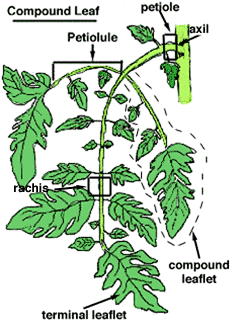
|
|
|
The tomato plant has compound leaves. A compound leaf is made up of leaflets which are distributed along the leaf rachis. While the entire leaf is connected to the stem by the petiole, the leaflets are connected to the rachis of the leaf by the petiolule. Some of the leaflets on this leaf are compound as well.
| |
Petioles |
|
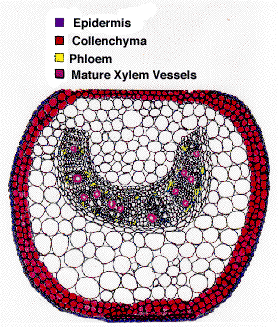
|
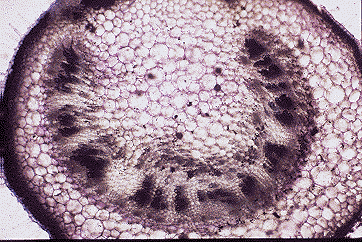
petiole cross section |
|
Just inside the epidermis of the petiole lie several layers of collenchyma . This tissue offers stuctural support while still allowing for flexibility in the petiole. The vascular tissue is arranged in a semi-cylinder in the center of the petiole. The bundles are bicollateral (Hayward 1938), with phloem on the inner and outer regions of the vascular semi-cylinder.
For more information and pictures click on petioles | |
Blades |
|
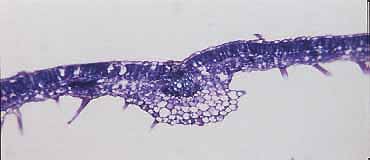 cross section of leaf midrib |
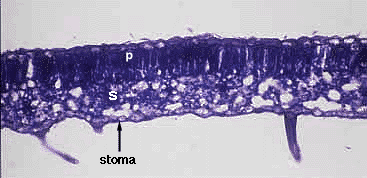 cross section of leaf (p-palisade mesophyll, s-spongy mesophyll) |
|
Most leaves are protected by a thin outer cuticle. Just inside the cuticle lies the epidermis. Note that the epidermis surrounds the leaf and is therefore visible on the abaxial (lower) and adaxial (upper) sides of the leaf in cross section. The epidermis contains stomata. Note the stoma on the abaxial side of the leaf in the cross section on the right. For more information about stomata please scroll down. In the center of the leaf lies the mesophyll. The mesophyll consists of two different cell types. Palisade mesophyll is composed of oblong, upright parenchyma cells. Spongy mesophyll consists of more irregularly shaped parenchyma cells arranged in a loose structure. Most of the plant's photosynthesis takes place in the mesophyll of the leaf.
|
|
Midrib |
|
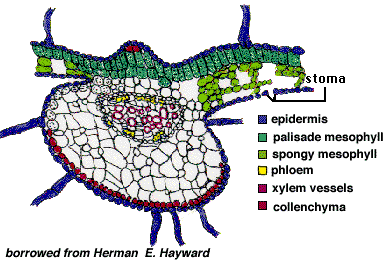
|
|
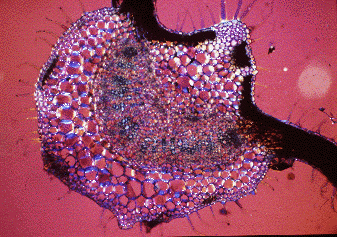
cross section through leaf midrib with polarized light
|
|
| The leaf contains many vascular bundles distributed in veins throughout the leaf. The leaf's main vein runs through the midrib. Typical plants have leaves with collateral bundles. The xylem is on the adaxial side of the vascular bundle, while the phloem is on the abaxial side of the bundle. In contrast, tomato leaves, like the tomato petiole, have bicollateral bundles. The xylem is in the center of the vein with the phloem distributed on both the adaxial and abaxial sides of the bundle (Hayward 1938). For more information about leaf venation please scroll down. | |
Veins | |
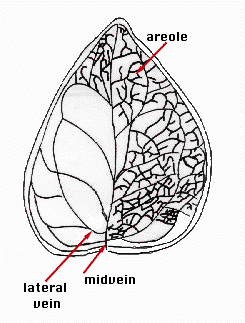 This diagram shows a partial venation pattern. |
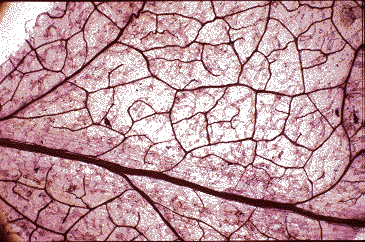
leaf clearing |
|
The leaf's vascular bundles are arranged in veins that run throughout the leaf. The tomato leaf exibits reticulate venation. This form of venation is common in dicotyledon leaves. The midvein runs through the midrib and is the main vascular bundle in the leaf. Lateral veins branch off of the midvein. These veins continue to branch, becoming smaller and smaller. These smaller veins eventually will either meet to form small boxes called areoles, or they will terminate leaving a free bundle end. In reticulate venation no cell is more than six cells away from a vascular bundle.
If you are interested in further information about venation and would like to see more leaf clearings click on Venation Patterns |
|
Stomata | |
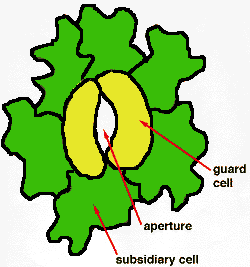
|
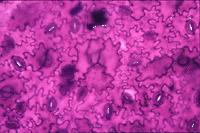 epidermal peel |
|
All gaseous exchange occurs through the stomata. The leaf epidermis contains many stomata. The stoma's opening, or aperture, is controlled by the two guard cells. The guard cells change shape to open and close the aperture. Surrounding the guard cells are subsidiary cells. Below the epidermis lies a substomatal chamber where the parenchyma cells form an air space.
Connect to the Stomata page if you would like to see an enlarged version of this epidermal peel and are interested in more information about stomata. |
|
Trichomes | |
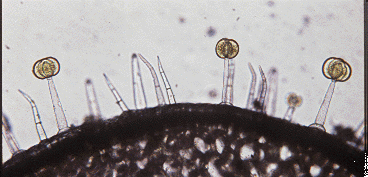
|
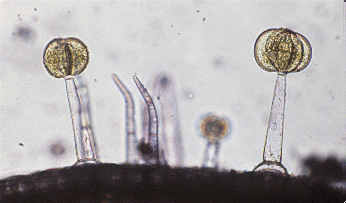
|
| Trichomes occur in the epidermis of many plants. Trichomes are abundant in tomato plants. Here we see two types of trichomes found in tomato, multicellular hairs and glandular trichomes. The glandular trichomes are responsible for secreting a yellow substance that gives off that characteristic "tomato plant" smell. | |